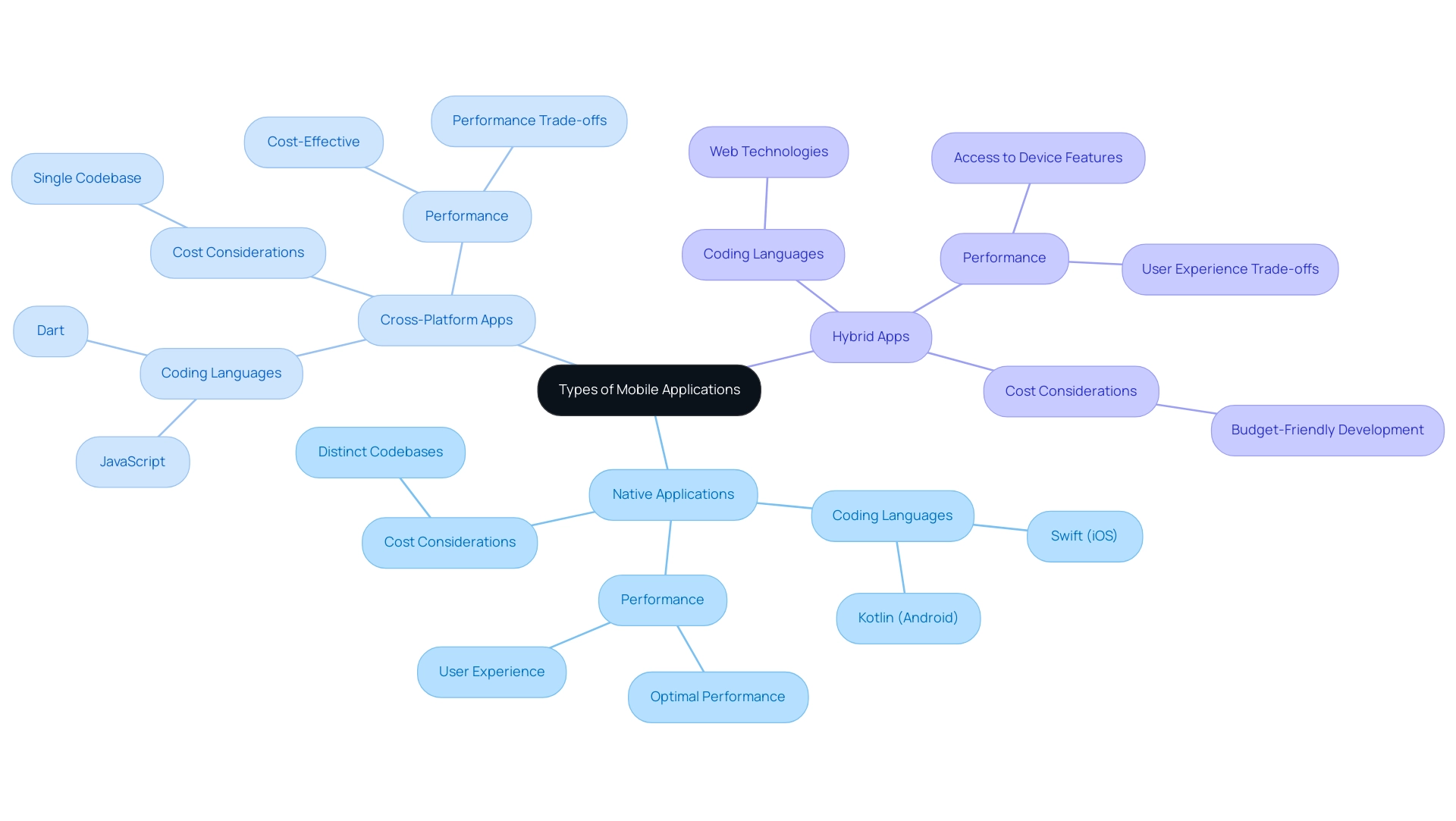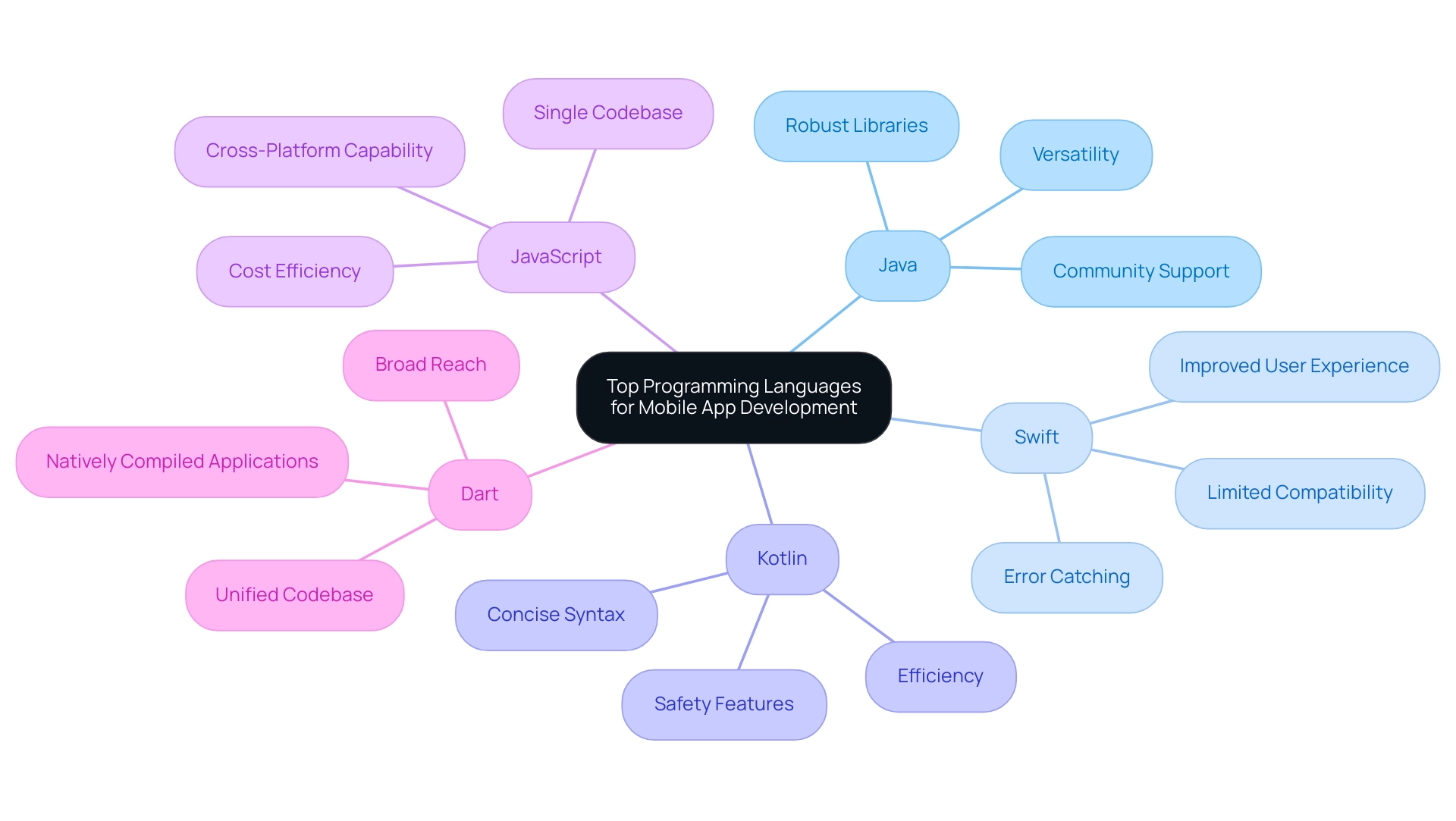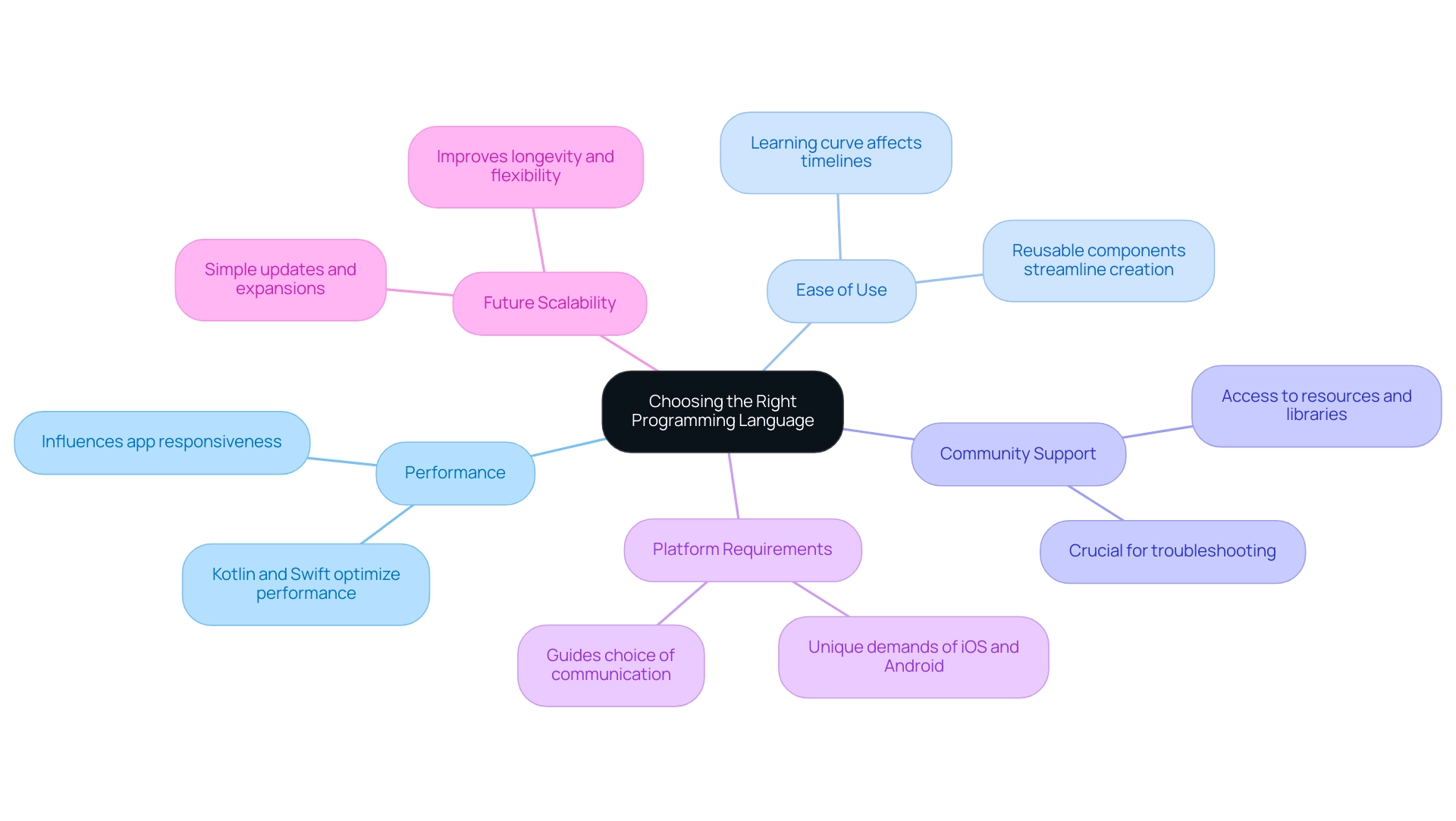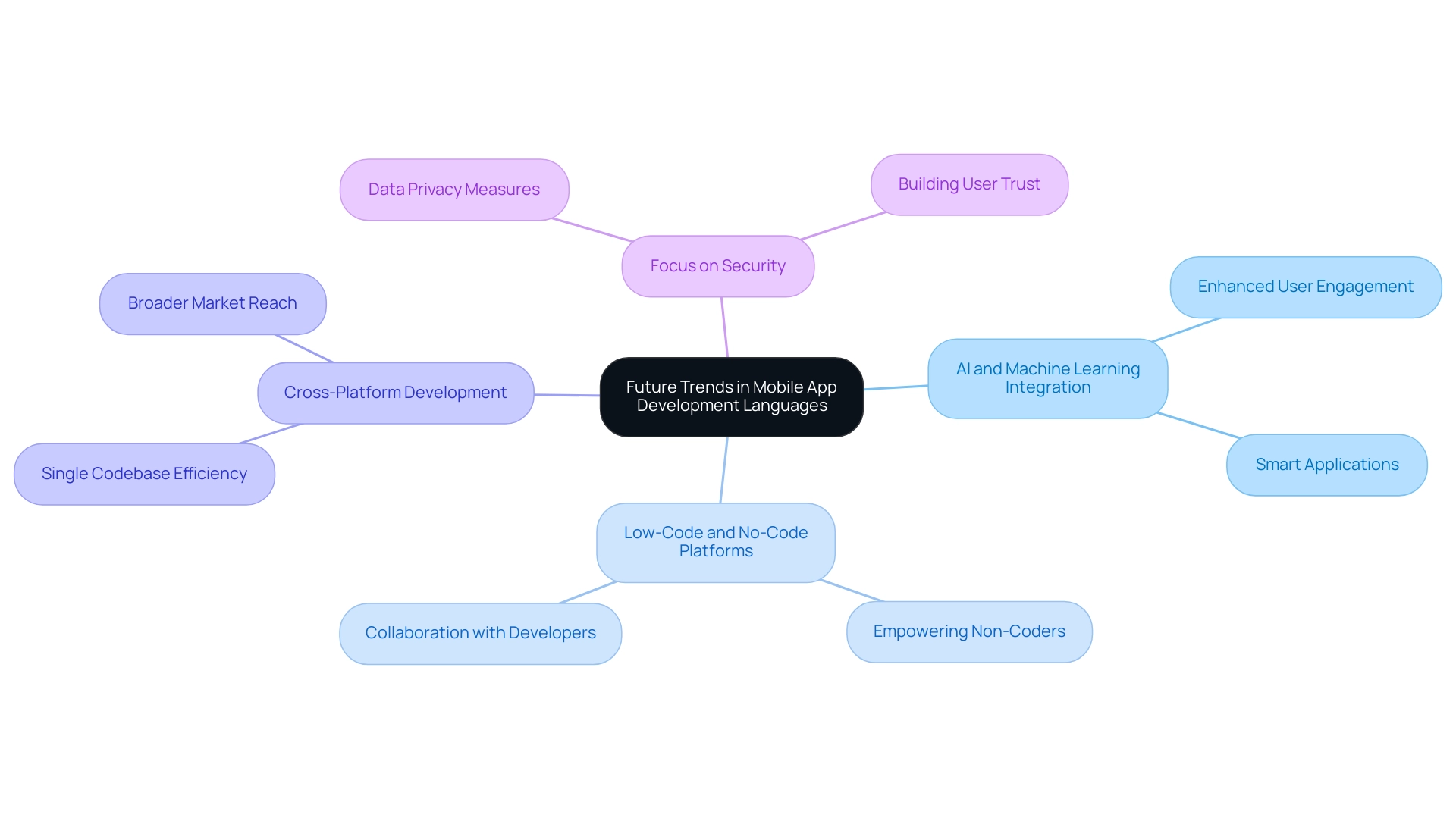Introduction
In the dynamic world of mobile app development, understanding the intricacies of programming languages is paramount for success. As the demand for innovative applications continues to surge, developers must navigate through a landscape filled with diverse options and evolving technologies.
This article delves into the essential stages of mobile app development, categorizing applications into:
- Native
- Cross-platform
- Hybrid
While also spotlighting the top programming languages that drive this industry forward. Key considerations in selecting the right language are explored, alongside future trends that are set to reshape the development landscape.
By grasping these fundamental aspects, developers can enhance user engagement, optimize performance, and ultimately create applications that resonate with users in an increasingly competitive market.
Understanding Mobile App Development
Mobile app creation is a multifaceted process involving the design of applications intended for mobile devices, such as smartphones and tablets. This intricate process unfolds across several crucial stages:
- Planning
- Design
- Implementation
- Testing
- Deployment
Each phase requires careful consideration of user experience, performance, and device compatibility.
Remarkably, the programming languages for mobile apps selected for creation greatly influence the overall efficiency and effectiveness of the process. A well-optimized language not only enhances app performance but also plays a pivotal role in user engagement, which is critical given that approximately 71% of app users tend to churn within the first 90 days of downloading an app. According to Gartner, global IT spending is expected to hit about $4.6 trillion in 2023, underscoring the financial landscape of mobile app development.
Additionally, a case study on tablet usage reveals that tablet users are more likely to pay for gaming apps due to the enhanced user experience provided by larger screens, indicating a profitable market for creators of gaming applications. Furthermore, apps like Calm and Glide are at the forefront of current mobile app trends, offering innovative features that engage users effectively. Consequently, grasping the dynamics of programming languages for mobile apps is essential for programmers to recognize how these choices can either bolster or impede their projects.
By mastering these fundamentals, developers position themselves to create apps that not only meet user expectations but also foster long-term loyalty.

Types of Mobile Applications: Native, Cross-Platform, and Hybrid
Mobile applications can be classified into three primary categories: native, cross-platform, and hybrid.
-
Native applications are customized specifically for one platform, either iOS or Android, utilizing platform-specific coding such as Swift for iOS and Kotlin for Android. This specialization allows native apps to deliver optimal performance and user experience, though it necessitates maintaining distinct codebases for each platform.
-
Cross-platform apps leverage a single codebase, enabling them to operate across multiple platforms. They are commonly developed using programming languages for mobile apps such as JavaScript or Dart, providing a more cost-effective solution while often sacrificing some performance nuances.
-
Hybrid apps represent a blend of both native and web applications, allowing developers to utilize web technologies while still accessing essential device features.
With the rise of companies like DoorDash, which holds over 50% market share in the food delivery sector, the significance of mobile applications cannot be overstated. Choosing the right app type is crucial, as your app is an evolving product that will grow with your business. Additionally, hybrid app creation is more budget-friendly, allowing for a single investment to create an app for multiple platforms, which is particularly appealing for e-commerce directors.
This comprehensive understanding of app categories is essential when selecting the most appropriate programming languages for mobile apps, as it directly impacts the application's performance, scalability, and overall user engagement.

Top Programming Languages for Mobile App Development
In the swiftly changing environment of mobile application creation, certain programming languages for mobile apps stand out as vital resources for programmers in 2024. Here’s a closer look at the most popular ones:
-
Java: Long regarded as the backbone of Android development, Java boasts versatility and a robust collection of libraries, making it a go-to choice for many developers. Its extensive community support ensures that resources are always available for troubleshooting and innovation.
-
Swift: Introduced by Apple, Swift is designed specifically for iOS applications. Its modern syntax and powerful features significantly enhance developer productivity, allowing for streamlined coding processes. As noted by research expert Lionel Sujay Vailshery, "Swift's refined error catching and debugging capabilities can lead to reduced creation times and improved user experiences." However, it is important to note that Swift's ecosystem remains limited to Apple devices, which may pose challenges for cross-platform programming. Advantages of Swift include simplified error catching and debugging, resulting in reduced programming time and better user experience, while a disadvantage is its limited compatibility with non-Apple operating systems. In a case study titled 'Swift for iOS Application Creation,' it was demonstrated that Swift streamlines the creation process and enhances Objective-C, making it simpler for programmers to build feature-rich applications, ultimately providing a better user experience.
-
Kotlin: Officially endorsed for Android programming, Kotlin is celebrated for its concise syntax and emphasis on safety features, making it a favored option among programmers who prioritize efficiency and reliability.
-
JavaScript: Frequently used in cross-platform frameworks like React Native, JavaScript enables programmers to build applications for both iOS and Android from a single codebase, thus simplifying the creation process and lowering expenses.
-
Dart: Surging in popularity alongside the Flutter framework, Dart allows for the creation of natively compiled applications across mobile, web, and desktop platforms from a unified codebase, making it an appealing option for programmers aiming for broad reach and performance.
By comprehending these programming languages for mobile apps and their specific benefits, developers are better prepared to choose the suitable tools for their projects, ensuring they stay competitive in the constantly evolving mobile app creation environment.

Choosing the Right Programming Language: Key Considerations
Choosing the suitable programming option for mobile app development involves a careful evaluation of several critical factors:
- Performance: Different programming systems yield varying performance levels, directly influencing the app's responsiveness and overall user experience. For instance, programming languages for mobile apps like Kotlin and Swift are crafted to enhance performance on their respective platforms, resulting in smoother interactions.
- Ease of Use: The learning curve linked to a programming system greatly affects project timelines and team efficiency. Languages that emphasize reusable components can streamline the creation process, as noted by Michal Kapias, a Chief Technology Officer who stresses placing client needs first to achieve a harmonious balance among time, cost, and functionality.
- Community Support: A strong community around a programming system is invaluable, offering crucial resources, libraries, and frameworks that accelerate the creation process. This support can be crucial for troubleshooting and enhancing productivity.
- Platform Requirements: Understanding the unique demands of the target platform—whether iOS or Android—is vital in guiding the choice of communication. Each operating system has its nuances that can dictate the most suitable programming approach.
- Future Scalability: Anticipating future updates and the scalability of the app are essential considerations. A coding system that permits simple updates and expansions can greatly improve the longevity and flexibility of the application.
Integrating these aspects into the decision-making process allows programmers to select programming languages for mobile apps that align with their project needs, ultimately boosting the chances of successful app creation. As emphasized in recent surveys, the emphasis on performance and usability continues to be a top priority among programmers, reflecting current trends in the industry. Furthermore, statistics from 2020 indicate that a significant percentage of tasks in U.S. tech startups were assigned to freelance professionals, highlighting the importance of choosing the appropriate coding systems to meet diverse project requirements.
Furthermore, the case study on blockchain technology demonstrates how programming choices can improve security and transparency in mobile application creation, while also revealing integration complexities and public perception challenges. Finally, the latest news on software developer engagement rates in 2023 indicates a growing interest in coding systems that prioritize performance and usability, further emphasizing the relevance of these considerations in the current landscape.

Future Trends in Mobile App Development Languages
The landscape of programming languages for mobile apps is in a state of constant evolution, shaped by technological advancements and market demands. Notable trends to watch include:
- Increased Integration of AI and Machine Learning: With the rapid advancements in AI technologies, programming tools that facilitate AI integration are becoming increasingly vital. This shift enables creators to build smarter, more responsive applications that enhance user engagement and functionality.
- Growth of Low-Code and No-Code Platforms: These platforms are transforming app creation by allowing individuals with minimal coding backgrounds to produce applications efficiently. This trend could redefine the role of traditional programming tools, making it essential for developers to adapt to a new collaborative environment.
- Expansion of Cross-Platform Development: As businesses seek broader reach through cross-platform solutions, programming languages for mobile apps such as Dart and JavaScript are gaining prominence. These programming systems streamline the creation process by enabling a single codebase to operate across multiple operating systems, ultimately conserving time and resources.
- Heightened Focus on Security: In a time of growing data privacy issues, programming systems emphasizing strong security features will be essential in app creation. Developers must ensure that their applications can withstand security threats while maintaining user trust.
Adding to the relevance of these trends, recent responses from 5,825 coders highlight the growing interest and engagement in mobile app programming tools. Furthermore, as noted, Hetzner has been acknowledged as the most-admired cloud platform for the second consecutive year, emphasizing the significance of choosing the appropriate programming languages for mobile apps and platforms for mobile app creation. Additionally, for businesses lacking a dedicated development team, hiring developers in India has emerged as a viable option to enhance application development, leading to the creation of high-quality applications that improve user experience.
By remaining attuned to these emerging trends, developers can strategically position themselves to harness new opportunities within the mobile app development arena, enhancing their competitive edge in a rapidly changing environment.

Conclusion
In the fast-evolving realm of mobile app development, understanding the critical stages and the diverse types of applications is essential for developers striving for success. From the meticulous planning and design phases to the final deployment, each step plays a vital role in shaping user experience and performance. The choice of programming language significantly influences these outcomes, impacting everything from app responsiveness to user engagement. Recognizing the characteristics of native, cross-platform, and hybrid apps allows developers to align their strategies with the needs of their target audience, ensuring that their applications stand out in a crowded marketplace.
The exploration of top programming languages—Java, Swift, Kotlin, JavaScript, and Dart—reveals the tools that are shaping the future of mobile applications. Each language offers unique advantages, tailored to different platforms and development needs. By carefully evaluating performance, ease of use, community support, platform requirements, and future scalability, developers can make informed decisions that enhance their projects' chances of success.
Looking ahead, trends such as the integration of AI and machine learning, the rise of low-code platforms, and the growing focus on security will continue to redefine the landscape of mobile app development. Staying informed about these shifts not only equips developers with the knowledge needed to adapt but also positions them to leverage emerging opportunities effectively. By mastering these essential aspects, developers can create applications that not only meet user expectations but also foster long-term loyalty in an increasingly competitive market.





